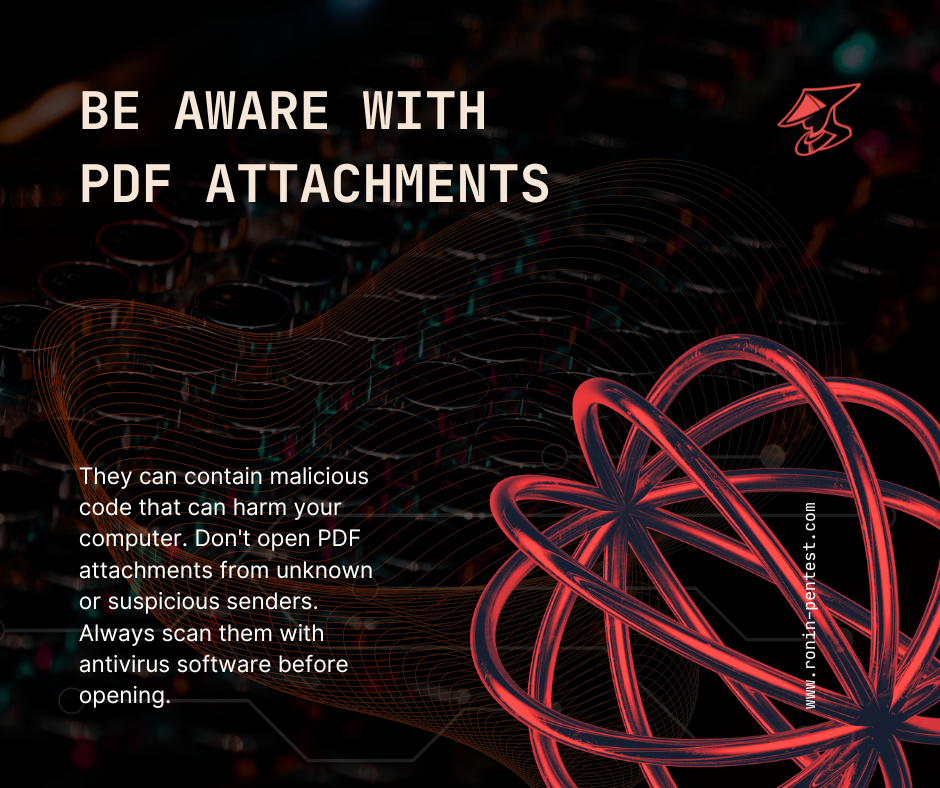How to Protect Yourself from PDF Attachment Exploits
by Ben Brown | 07/03/2023

by Ben Brown | 07/03/2023

PDF files are very common and useful for sharing documents online. However, they can also be used by hackers to infect your computer with malware or steal your data. In this blog post, we will explain what PDF attachment exploits are, why they are still active, how to avoid them, and what to do if you are infected.
A PDF attachment exploit is a type of cyberattack that uses a malicious PDF file to execute code on your computer. The code can do various things, such as:
• Download and run malware that can spy on you, encrypt your files, or damage your system.
• Exfiltrate the contents of the PDF file or other files on your computer to a remote server.
• Redirect you to a phishing website that can steal your credentials or personal information.
There are different ways that a PDF file can execute code. Some of them are:
• Exploiting a vulnerability or flaw in the PDF reader application or browser that you use to open the file. This can allow the attacker to run arbitrary code on your computer without your knowledge or consent.
• Using scripting technologies like AcroForms or XFA Forms that are meant to add interactive features to PDF documents. These can be abused by the attacker to inject JavaScript code that can run in the context of the PDF file or the browser.
• Using embedded links or objects that can trigger external requests or actions when you click on them or open the file. These can be used by the attacker to load malicious content from another source or perform actions on your behalf.
PDF attachment exploits are still active because they are effective and hard to detect. Some of the reasons are:
• PDF files are widely used and trusted by many people and organizations. They are often seen as harmless and legitimate documents that can be opened without any risk.
• PDF files can contain various types of content and features that can make them look appealing and convincing. They can also be manipulated by the attacker to hide their malicious intent or evade security checks.
• PDF files can bypass some security measures that are designed to block executable files or scripts. For example, they can have a .pdf extension that makes them look like normal documents, but actually contain executable code or scripts inside.
• PDF readers and browsers may not be updated regularly or have adequate security settings. This can make them vulnerable to exploits that take advantage of known or unknown flaws in their software.
The best way to avoid a PDF attachment exploit is to be careful and vigilant when dealing with PDF files, especially those that come from unknown or suspicious sources. Here are some tips to help you:
• Do not open PDF attachments or links that you receive in unsolicited emails or messages. They may be part of a phishing or spam campaign that tries to trick you into opening malicious files.
• Do not open PDF files that have unusual names, extensions, sizes, or contents. They may be disguised as something else or contain hidden code or scripts.
• Do not enable JavaScript or other scripting features in your PDF reader or browser unless you trust the source and need them for a specific purpose. They may be used by the attacker to run malicious code on your computer.
• Do not click on any links or objects inside a PDF file unless you trust the source and know what they do. They may redirect you to a malicious website or perform unwanted actions on your behalf.
• Update your PDF reader and browser regularly and use the latest versions available. They may have patches or fixes for known vulnerabilities that can prevent exploits from working.
• Use antivirus software and firewall on your computer and scan any PDF files that you download or receive before opening them. They may detect and block malware or malicious code that may be hidden in the files.
If you suspect that you have been infected by a PDF attachment exploit, you should take immediate action to limit the damage and remove the infection. Here are some steps to follow:
• Disconnect your computer from the internet and any other networks. This can prevent the malware from spreading further or communicating with its command and control server.
• Scan your computer with antivirus software and remove any malware or malicious files that are found. You may need to use a bootable antivirus disk or USB drive if your system is severely compromised.
• Restore your computer from a backup or reinstall your operating system and applications if necessary. This can ensure that any traces of the infection are gone and your system is clean and secure.
• Change your passwords and monitor your accounts for any suspicious activity or transactions. You may have been a victim of identity theft or fraud if the attacker has stolen your credentials or personal information.
PDF attachment exploits are a serious threat that can compromise your computer and data. By following the tips and steps above, you can protect yourself from them and stay safe online.
Start scanning your projects for free. You will get a free breakdown of your security status. Start securing your future now.
Get started